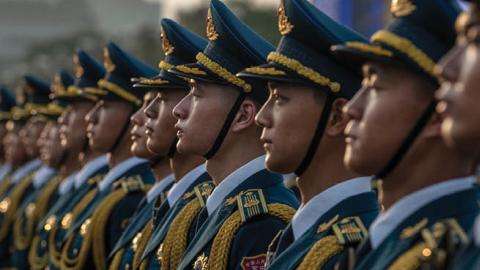This past March, Admiral Philip Davidson warned Congress that China could assault Taiwan “in the next six years.” Davidson, a career surface-warfare officer who was then commander of the U.S. Indo-Pacific Command, spoke with unusual candor during his testimony. Military officers generally refrain from such frankness. The tongue-in-cheek Washington saying that officers present civilians with three options — diplomacy, moderate action, or capitulation — is neither funny nor baseless.
Davidson is undeniably correct that conquering and absorbing Taiwan is a central Chinese strategic objective. China’s long-term goal, as Xi Jinping tacitly but clearly articulated in his recent Chinese Communist Party centenary-commemoration speech, is to dominate global politics and thereby achieve “national rejuvenation.” Attaining this goal requires, first, subduing the First Island Chain (the string of island clusters closest to the continental coast of East Asia) and then the broader Indo-Pacific, and using control of them to manipulate global economic interaction. Taiwan is central to this strategy, not only because of its role in the CCP’s self-identity but also because of its strategic position. It sits at the First Island Chain’s center, linking the Philippines in the south to Japan in the north. It lies along major Chinese aerial and maritime routes. Moreover, missiles fired from Taiwan can target numerous Chinese military bases and population centers. Taiwan is China’s primary military target.
Contrary to the prevailing policy wisdom in the United States, there’s no reason for China to restrain itself from further escalation. The People’s Liberation Army is not only involved in “hybrid” and “gray zone” activities — cyber, information, and irregular warfare, and quasi-military activities that stop short of traditional combat. Rather, its objective is to shape the battlefield and, in the case of its probing against Taiwan, to gather valuable tactical and operational intelligence about Taiwanese capabilities and responses to such military challenges as violations of air and maritime space. China took an incremental approach against the perceived Uyghur threat in Xinjiang, and it steadily curbed freedoms in Hong Kong. But then the CCP escalated in both cases, significantly increasing pressure on the Uyghurs and on Hong Kong since the autumn before the pandemic began. It is achieving its objectives — cultural and demographic genocide of Uyghur Muslims and elimination of Hong Kong’s parliamentary democracy — without any notable international backlash.
President Biden’s visit to Europe last month did include tougher anti-Chinese rhetoric, at the same time that populations in Eastern Europe pressured their governments to take a stronger stand against China after the Wuhan lab-leak revelations. But the undertow that defined American and European China policy throughout the 2000s and 2010s persisted: The stakes of confrontation with Beijing are too high, and progress on issues such as climate change should not be compromised for ignoble power politics.
In short, there seems to be no emergent global anti-Chinese military coalition — that is, no alliance to which America’s European allies will comfortably commit themselves before conflict.
The question the CCP must ask itself, therefore, is: Given the current strategic and political situation, what are the odds that the PLA can gain a quick victory over Taiwan and preclude American intervention? Additionally, in a broader Indo-Pacific conflict, what are China’s chances of victory?
Grasping this question requires beginning with geography, the unchanging influence on human political conditions. Once again, Taiwan is China’s primary target, both because it lies at the heart of the First Island Chain and because China regards Taiwan’s prosperous democracy as a threat to its authoritarian regime. Breaking the island republic would ease the PLA’s task in threatening, and ultimately taking, military action against nearby Japan and the Philippines, pressuring their long, exposed coastlines from multiple angles. Conversely, a surviving Taiwan could be used to “choke” China by containing the PLA’s naval power (and Chinese merchant-maritime power) within the First Island Chain. Geographically, China holds a strong position over Taiwan. It can concentrate forces throughout its Eastern and Southern Theater Commands, particularly if the PLA does not face a concurrent threat from Vietnam in the South China Sea. And the Taiwan Strait is only 100 miles wide.
Indeed, the PLA’s recent probing exercises against Taiwan, such as its April 2021 dispatch of 25 fighter jets in violation of Taiwan’s Air Defense Identification Zone, have indicated its broader operational approach. It would probably bracket Taiwan from the north and south using on one side a mass fighter surge and on the other a ground-aviation-supported carrier movement. Concurrently, the PLA would seek to bombard Taiwan with its arsenal of ground- and air-launched cruise and ballistic missiles, targeting airfields first to ensure the PLA’s air supremacy. It would then concentrate support on a handful of beaches fit for amphibious assault, attempting to gain a foothold as rapidly as possible and pouring in follow-on forces to overwhelm conventional resistance.
The PLA recognizes that a protracted insurgency would be likely. Hence its reorganization of the People’s Armed Police: The PAP’s Second Mobile Contingent is based in Fujian Province, directly across the Taiwan Strait. But a Pacific war would be fought at sea, not on land. Unless China chose to invade India, Vietnam, or the Philippines — three dubious strategic choices — ground combat would be restricted to assaults on specific islands and to fighting for Taiwan. The PLA ground forces could therefore afford to deploy the bulk of their combat power to Taiwan to stabilize the situation without undermining PLA effectiveness against other adversaries.
Foremost among these other adversaries is the United States, assuming that America would honor the Taiwan Relations Act’s guarantees and view a Chinese invasion of Taiwan with “sufficiently grave concern.” And it is here that geography and force structure intersect to create a uniquely dangerous strategic situation.
China’s immediate objective need not be conquering Taiwan and eliminating all resistance there. Rather, it need only neutralize all forces on Taiwan that can attack PLA ships and aircraft and thereby disrupt PLA operations in the western Pacific. Thus, truly disrupting Chinese plans would require preventing PLA sea and air control of Taiwan and preserving enough offensive capability on Taiwan to strike back, either against a PLA naval force or against bases on the mainland. This would require forward-deploying forces to Taiwan or having naval assets near enough to the First Island Chain to support Taiwan during China’s opening bombardment and naval envelopment.
However, current American force structure is not designed for this sort of engagement. The U.S. Navy’s combat power stems from its aircraft-carrier strike groups and submarine forces. Its “Expeditionary Strike Groups,” glorified amphibious-assault units, would be less relevant in a high-end naval conflict. Big-deck amphibs may field F-35B planes, but the lack of their own intelligence, surveillance, reconnaissance, and targeting assets and the limited range of “vertical take-off and landing” (VTOL) fighters and “short take-off and vertical landing” (STOVL) fighters would hamper their effectiveness. American carrier strike groups are more effective: A two-carrier strike group with two full air wings would field 80 to 100 fighter aircraft.
But with the Cold War’s conclusion, the U.S. Navy traded air-wing diversity for ground-support specialization. Gone are the long-range interceptors, specialist anti-submarine and anti-surface strike aircraft, purpose-built electronic-warfare platforms, and their own tankers. An air wing consisting of F/A-18 Hornet combat jets and F-35C Lightning jets would be able to provide the carrier strike group with its critical envelope of air superiority. But its limited range would restrict its ability to conduct strikes beyond the range of China’s most numerous ground- and air-launched anti-ship missiles. Thus, American planners would have to choose between deploying a carrier strike group within 600 miles of the Chinese coastline while relying upon the carrier’s air-defense destroyers to neutralize Chinese missiles, and holding the carriers out of China’s missile range but forgoing their ability to affect the skies over Taiwan.
A submarine-centric approach might be more effective. The U.S. Navy’s most modern Seawolf- and Virginia-class submarines, particularly if the Virginia Payload Module Block V boats have reached the fleet, would frustrate Chinese objectives. Even a handful of submarines could delay the PLA’s obtaining sea control, giving Taiwan valuable time to prepare its defenses and erode Chinese forces. And America’s Ohio-class guided-missile submarines could function as arsenal ships, attacking land targets with their 154 Tomahawk missiles. Geographical challenges persist, however. The U.S. Navy must have enough submarines in the western Pacific and receive sufficient warning of a Chinese attack. Otherwise, American submarines would be overwhelmed or arrive too late to turn back a Chinese assault.
The United States is in a strategic bind. American naval forces are not optimized to fight within range of the enemy’s most lethal capabilities. But the most effective American strategy demands aggressive operations that would place American forces close to China’s coastline.
These force-structure and geographical constraints make a blockade from far away the most likely American option. Much as Britain’s naval power choked Imperial and Nazi Germany and Napoleonic France before it, America’s sea forces could be used to isolate China and, with allied cooperation, destroy its economic productivity even if it did take Taiwan.
The difficulty in conducting a far blockade is again geographical. There is no natural strongpoint, no Pacific equivalent of Scapa Flow from which an American or allied force could control all major chokepoints. This also modifies Chinese strategy. Naturally, the PLA must be concerned with the South China Sea and the Straits of Malacca and the East China Sea and the western Pacific. However, given America’s likely reliance on long-term abrasion of China’s economy, the PLA would have a clear incentive to move first, forcing a confrontation to break the blockade. And the farther out of Chinese missile range the U.S. held its carrier groups, the more vulnerable the Philippines or Japan would become. The PLA might therefore be able to force a fleet action in the Philippine Sea under the cover of its medium-range missiles and with support from ground-based naval aviation.
Chinese victory in this context would not be guaranteed. But a Sino–American fleet action under these circumstances would constitute the most evenly matched naval battle since Midway. Balanced fleet actions are close-run affairs. Take Jutland, that North Sea clash of dreadnoughts: Had Germany’s capital ships scored a few extra hits or had the U-boat strategy of Germany’s High Seas Fleet reduced British numbers, an even clash of battle lines could have resulted in German victory. Similarly, Midway took a remarkably break — the arrival of American strike aircraft during Japanese refueling — to tip the battle in the United States’ favor. The result of a Sino–American fleet action would be equally uncertain.
In any case, each of these considerations is irrelevant absent a strategy to defeat China at sea and absent the education, fleet architecture, planning, exercises, and training that support a strategy to deter or, if need be, defeat China. Flatline defense budgets, a stubborn fixation on the political nature of Sino–American antagonism rather than on military and strategic facts, the growing emphasis on climate-change considerations, interservice bureaucratic competition to the detriment of force structure, and the complete lack of consensus over the nature of the threat China poses will not produce a military capable of deterring or defeating China. Nations go to war with the militaries they have. We are no different. American demands for a “short war” and “exit strategy” throughout the 2000s may be fulfilled in a future war. The simplest exit strategy would be capitulation. American policy does not intend this. But it is an inexorable consequence of today’s half measures and inaction.
Read in National Review

















